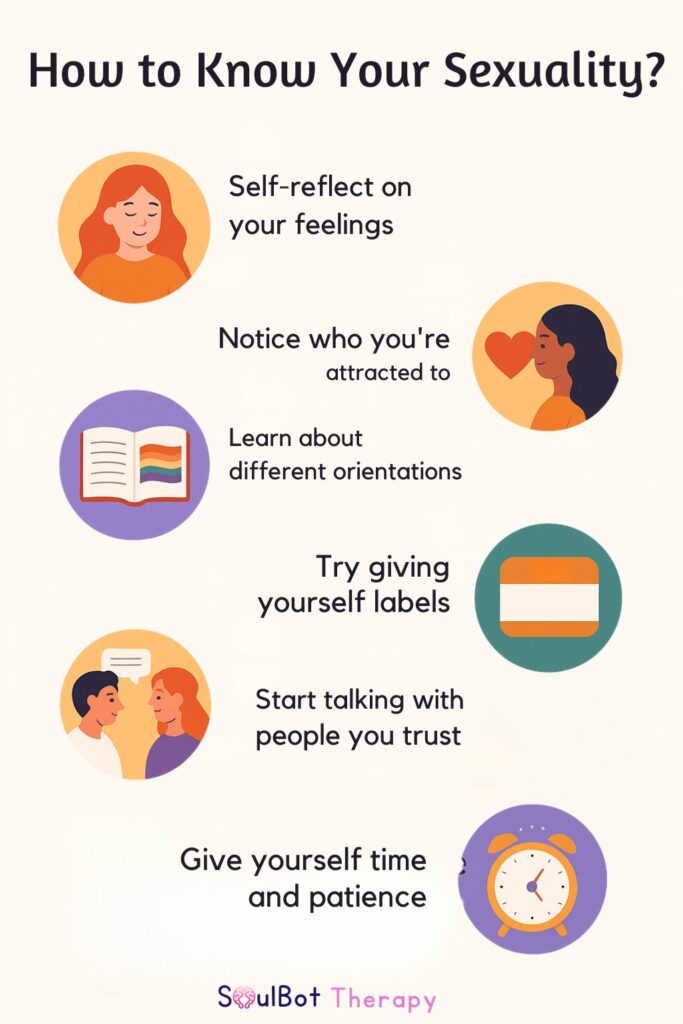What is sexuality? It’s not just about who you’re attracted to. It’s how you relate, express, and experience identity through love, intimacy, and connection.
For many, the journey of understanding their sexuality is confusing. Others feel clear, but lack the language. And for some, it changes over time, fluid, evolving, deeply personal.
This guide breaks it all down: the different types of sexuality, how orientation differs from identity, myths to unlearn, and how tools like AI mental health companions can help you explore safely and without judgment.
💫 Take the Sexuality Quiz — Discover where your compass points and embrace your authentic self.📊 Did You Know?
According to a 2023 Gallup poll, over 20% of Gen Z adults in the U.S. identify as somewhere along the LGBTQ+ spectrum, showing an unprecedented shift toward visibility, acceptance, and sexual identity exploration.
What Is Sexuality, Really?
Sexuality is a broad term that includes:
- Sexual orientation (who you’re attracted to)
- Sexual identity (how you label or understand yourself)
- Sexual expression (how you express desire, gender, and intimacy)
- Sexual behaviour (how you act on your feelings)
It’s not binary. It’s not static. And it’s not always clear at first.
This makes what is sexuality not just a question, but a journey.
What are the Different Types of Sexuality?
There are many valid ways to experience and express sexuality. Here are some of the most commonly identified types:
| Orientation | Description |
|---|---|
| Heterosexual | Attraction to the other gender |
| Homosexual | Attraction to the same gender |
| Bisexual | Attraction to more than one gender |
| Pansexual | Attraction regardless of gender identity |
| Asexual | Little or no sexual attraction to others |
| Queer | A broad, inclusive term for non-heteronormative identities |
| Questioning | Still exploring or not ready to label |
Everyone experiences their sexuality differently- some use labels, some don’t. That’s okay.
Understanding Sexual Orientation vs Sexual Identity
These terms are often used interchangeably, but they’re not the same.
- Sexual Orientation = who you’re romantically/sexually attracted to
- Sexual Identity = the term or concept you use to describe that attraction
For example:
- A person may feel emotionally attracted to all genders (orientation) but prefer the label “queer” (identity).
- Another might avoid labels entirely, and that’s just as valid.
Can Sexuality Be Fluid or Change Over Time?
Yes — and this is more common than most people realise.
You may find:
- Certain experiences awaken parts of your identity
- Labels that once fit no longer do
- You shift between multiple forms of attraction across time
This doesn’t mean you were “wrong” before; it means you’re growing.
SoulBot, your AI mental health assistant, can help you journal emotional shifts, ask self-reflection questions, and track identity changes safely and privately.
Common Myths About Sexuality (That Need to Go)
❌ Myth 1: You must pick a label
✅ Truth: You don’t owe anyone a definition
❌ Myth 2: If it changes, it’s not real
✅ Truth: Sexuality is allowed to evolve
❌ Myth 3: You’re “confused” if you identify as queer or fluid
✅ Truth: Complexity ≠ confusion
Want more facts? Explore this inclusive resource by Planned Parenthood.

How to Know Your Sexuality: Questions, Tools & Safe Spaces
You don’t find yourself overnight, but here are some steps to support your sexual identity exploration:
✍️ Journaling Prompts:
- When do I feel most like myself?
- What types of attraction do I experience — romantic, sexual, emotional?
- Do I feel safe expressing affection or desire?
🧪 Self-Checks:
🌐 Safe Spaces:
- Online LGBTQ+ forums
- Local queer support groups
- AI therapy tools like SoulBot for reflection and identity validation
How AI Mental Health Support Can Help?
Not ready to talk to someone IRL? You’re not alone.
✅ SoulBot – AI Mental Health Companion can:
- Ask for emotionally intelligent reflection prompts
- Guide you through orientation and identity exercises
- Log evolving feelings over time
- Normalise your experience without judgment
Think of it as your non-judgmental support space, always available and always private.
You Don’t Owe a Label — But You Deserve to Feel Seen
Your sexuality is yours. You don’t need permission to name it, explore it, change it, or not explain it.
What matters is that you feel safe, empowered, and true to yourself.
And if that journey feels overwhelming, SoulBot is here, your private, always-on AI mental health companion.
👉 Talk to SoulBot – your AI Therapist anytime








